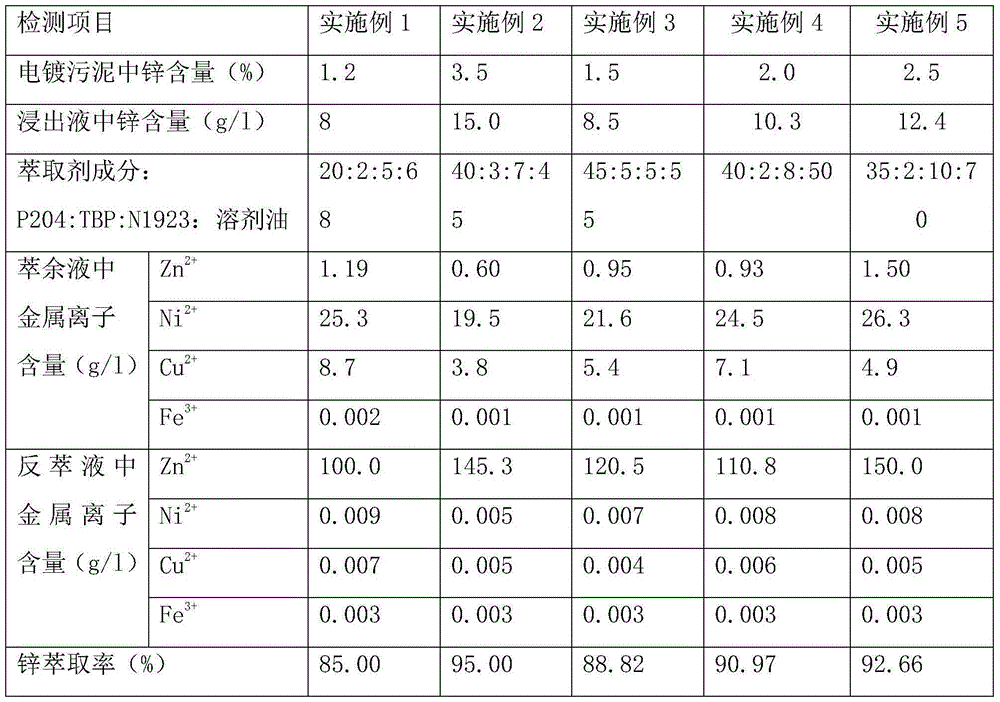Method of separating and recovering zinc from electroplating sludge
A technology of separation and recovery of electroplating sludge, applied in the field of metallurgy, can solve the problems of low market price, economical discount, and large consumption of auxiliary materials for zinc products, and achieve the effects of high added value of products, less consumption of auxiliary materials, and low production costs
- Summary
- Abstract
- Description
- Claims
- Application Information
AI Technical Summary
Problems solved by technology
Method used
Image
Examples
Embodiment 1
[0044] A method for separating and recovering zinc from electroplating sludge, comprising the following specific steps:
[0045] (1) Leaching treatment: the electroplating sludge is leached with inorganic acid, stop adding sulfuric acid when the pH in the electroplating sludge is 1.0, and then carry out solid-liquid separation to obtain leaching residue and leaching solution. The zinc ion content in the leaching solution is 8g / l, Ni ion content is 5g / l, Cu ion content is 5g / l;
[0046] (2) Neutralization and removal of iron and chromium: Adding mass concentration to the leaching solution in (1) is 8% sodium carbonate solution, adjusting the pH of the leaching solution to be 3.5, selectively precipitating iron and chromium, zinc remains in the solution, and then solid-liquid Separation to obtain leaching residue and leaching solution; the content of trivalent Fe ions in the leaching solution is 0.05g / l, and the content of chromium ions is 0.01g / l;
[0047] (3) Extraction: P20...
Embodiment 2
[0049] A method for separating and recovering zinc from electroplating sludge, comprising the following specific steps:
[0050] (1) Leaching treatment: the electroplating sludge is leached with inorganic acid, stop adding sulfuric acid when the pH in the electroplating sludge is 1.5, and then carry out solid-liquid separation to obtain leaching slag and leaching solution. The zinc ion content in the leaching solution is 15g / l, Ni ion content is 30g / l, Cu ion content is 30g / l;
[0051] (2) Neutralization and removal of iron and chromium: add a mass concentration of 9% sodium carbonate solution to the leaching solution in (1), adjust the pH of the leaching solution to be 4.5, selectively precipitate iron and chromium, zinc remains in the solution, and then solid-liquid Separation to obtain leaching residue and leaching solution; the content of trivalent Fe ions in the leaching solution is 0.02g / l, and the content of chromium ions is 0.008g / l;
[0052] (3) Extraction: P204 wit...
Embodiment 3
[0054] A method for separating and recovering zinc from electroplating sludge, comprising the following specific steps:
[0055] (1) Leaching treatment: leaching the electroplating sludge with inorganic acid, stop adding sulfuric acid when the pH in the electroplating sludge is 1.0, and then carry out solid-liquid separation to obtain leaching residue and leaching solution. The zinc ion content in the leaching solution is 8.5g / l, Ni ion content is 10g / l, Cu ion content is 8g / l;
[0056] (2) Neutralization and removal of iron and chromium: add mass concentration of 8% sodium bicarbonate to the leaching solution in (1), adjust the pH of the leaching solution to 4.0, selectively precipitate iron and chromium, zinc remains in the solution, and then solid-liquid Separation to obtain leaching residue and leaching solution; the content of trivalent Fe ions in the leaching solution is 0.01g / l, and the content of chromium ions is 0.007g / l;
[0057] (3) Extraction: P204 with a concent...
PUM
 Login to View More
Login to View More Abstract
Description
Claims
Application Information
 Login to View More
Login to View More - R&D
- Intellectual Property
- Life Sciences
- Materials
- Tech Scout
- Unparalleled Data Quality
- Higher Quality Content
- 60% Fewer Hallucinations
Browse by: Latest US Patents, China's latest patents, Technical Efficacy Thesaurus, Application Domain, Technology Topic, Popular Technical Reports.
© 2025 PatSnap. All rights reserved.Legal|Privacy policy|Modern Slavery Act Transparency Statement|Sitemap|About US| Contact US: help@patsnap.com



